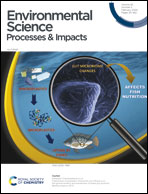Composition of indoor organic surface films in residences: simulating the influence of sources, partitioning, particle deposition, and air exchange†
Abstract
Indoor surfaces are coated with organic films that modulate thermodynamic interactions between the surfaces and room air. Recently published models can simulate film formation and growth via gas-surface partitioning, but none have statistically investigated film composition. The Indoor Model of Aerosols, Gases, Emissions, and Surfaces (IMAGES) was used here to simulate ten years of nonreactive film growth upon impervious indoor surfaces within a Monte Carlo procedure representing a sub-set of North American residential buildings. Film composition was resolved into categories reflecting indoor aerosol (gas + particle phases) factors from three sources: outdoor-originating, indoor-emitted, and indoor-generated secondary organic material. In addition to gas-to-film partitioning, particle deposition was modeled as a vector for organics to enter films, and it was responsible for a majority of the film mass after ∼1000 days of growth for the median simulation and is likely the main source of LVOCs within films. Therefore, the organic aerosol factor possessing the most SVOCs contributes most strongly to the composition of early films, but as the film ages, films become more dominated by the factor with the highest particle concentration. Indoor-emitted organics (e.g. from cooking) often constituted at least a plurality of the simulated mass in developed films, but indoor environments are diverse enough that any major organic material source could be the majority contributor to film mass, depending on building characteristics and indoor activities. A sensitivity analysis suggests that rapid film growth is most likely in both newer, more air-tight homes and older homes near primary pollution sources.

- This article is part of the themed collection: Atmospheric chemistry


 Please wait while we load your content...
Please wait while we load your content...